While My Guitar Gently Weeps
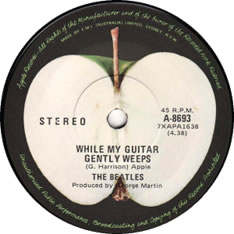 is a song by the English rock band the Beatles from their 1968 double album The Beatles (also known as “the White Album”).
is a song by the English rock band the Beatles from their 1968 double album The Beatles (also known as “the White Album”).
It was written by George Harrison, partly as an exercise in randomness after he consulted the Chinese I Ching.
The song also serves as a comment on the disharmony within the Beatles at the time. The recording includes a lead guitar part played by Eric Clapton, although he was not formally credited for his contribution.
Help!
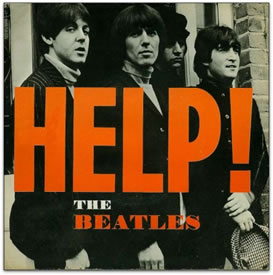 Is a song by the Beatles that served as the title song for both the 1965 film and its soundtrack album. It was also released as a single, and was number one for three weeks in both the United States and the United Kingdom.
Is a song by the Beatles that served as the title song for both the 1965 film and its soundtrack album. It was also released as a single, and was number one for three weeks in both the United States and the United Kingdom.
“Help!” was credited to Lennon–McCartney. John Lennon was the dominant writer, but the song was developed in songwriting session with Paul McCartney. During an interview with Playboy in 1980, Lennon recounted: “The whole Beatles thing was just beyond comprehension. I was subconsciously crying out for help”.
It was ranked no. 29 on Rolling Stone’s 500 Greatest Songs of All Time.
Composition
The documentary series The Beatles Anthology revealed that Lennon wrote the lyrics of the song to express his stress after the Beatles’ quick rise to success. “I was fat and depressed and I was crying out for ‘Help’,” Lennon told Playboy. Writer Ian MacDonald describes the song as the first crack in the protective shell Lennon had built around his emotions during the Beatles’ rise to fame, and an important milestone in his songwriting style.
In the 1970 Rolling Stone “Lennon Remembers” interviews, Lennon said that the song was one of his favorites among the Beatles songs he wrote, but he wished they had recorded it at a slower tempo. In these interviews, Lennon said he felt that “Help!” and “Strawberry Fields Forever” were his most honest, genuine Beatles songs and not just songs “written to order”. According to Lennon’s cousin and boyhood friend Stanley Parkes, however, “Help!” was written after Lennon “came in from the studio one night. ‘God,’ he said, ‘they’ve changed the title of the film: it’s going to be called ‘Help!’ now. So I’ve had to write a new song with the title called ‘Help!’.”
According to McCartney, he was called in “to complete it”, providing the “countermelody” arrangement, on 4 April 1965 at Lennon’s house in Weybridge.
Recording
The Beatles recorded “Help!” in 12 takes on 13 April 1965 using four-track equipment. The first nine takes concentrated on the instrumental backing. The descending lead guitar riff that precedes each verse proved to be difficult, so by take 4 it was decided to postpone it for an overdub. To guide the later overdub by Harrison, Lennon thumped the beat on his acoustic guitar body, which can be heard in the final stereo mix. Lead and backing vocals were recorded twice onto take 9, along with a tambourine. A reduction mix was applied to the two vocal tracks, taking three attempts (takes 10 to 12), freeing up a track for the lead guitar overdub. This was the group’s first use of two 4-track machines for “bouncing”.
The vocals were re-recorded for the film during a session on 24 May 1965 at CTS Studios, a facility specializing in post-synchronisation. In addition to attempting a better vocal performance, the session might have been done to eliminate the tambourine (which had been on the same track as the vocals) since no tambourine appeared in the film sequence. With the new vocals, a mono mix was created at CTS Studios which was used for the film soundtrack. Mixes for record releases were prepared on 18 June. For the mono version, Martin decided to use a mix of the opening chorus of take 12 edited to the remainder of the CTS film mix. Because all instruments were combined on a single track for the CTS session, it could not be used for a stereo mix, so the stereo mix was made from take 12.
I Saw Her Standing There
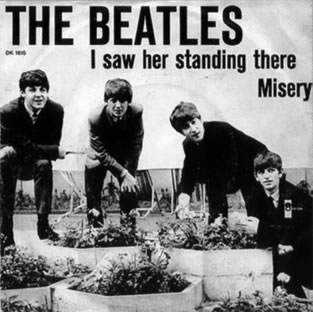 is a song by the English rock band the Beatles written by Paul McCartney and John Lennon. It is the opening track on the band’s 1963 debut album Please Please Me.
is a song by the English rock band the Beatles written by Paul McCartney and John Lennon. It is the opening track on the band’s 1963 debut album Please Please Me.
In December 1963, Capitol Records released the song in the United States as the B-side on the label’s first single by the Beatles, “I Want to Hold Your Hand”.
While the A-side topped the US Billboard chart for seven weeks starting 1 February 1964, “I Saw Her Standing There” entered the Billboard Hot 100 on 8 February 1964, remaining there for 11 weeks, peaking at No. 14.
The song placed on the Cashbox chart for only one week at No. 100 on the same week of its Billboard debut.
In 2004, “I Saw Her Standing There” was ranked No. 139 on Rolling Stone’s list of the 500 Greatest Songs of All Time.
Composition
The song was mainly written by Paul McCartney. Originally titled “Seventeen”, the song was apparently conceived by McCartney while driving home from a Beatles’ concert in Southport, Lancashire as a modern take on the traditional song “As I Roved Out”, a version of “Seventeen Come Sunday” that he had heard in Liverpool in 1960.
According to Beatles biographer Mark Lewisohn, McCartney worked out chords and changes for the song on an acoustic guitar, at the family home of his Liverpool friend and fellow musician Rory Storm, on the same night, 22 October 1962. Two days later, McCartney was writing lines for the song during a visit to London with his then-girlfriend Celia Mortimer, who was seventeen at the time herself. The song was completed about a month later at McCartney’s Forthlin Road home with Lennon.
McCartney later described in Beat Instrumental how he went about the song’s composition: “Here’s one example of a bit I pinched from someone: I used the bass riff from ‘Talkin’ About You’ by Chuck Berry in ‘I Saw Her Standing There’. I played exactly the same notes as he did and it fitted our number perfectly. Even now, when I tell people, I find few of them believe me; therefore, I maintain that a bass riff hasn’t got to be original”.
The lyrics were written on a Liverpool Institute exercise book. Remember, a book by McCartney’s brother Mike McCartney, includes a photograph of Lennon and McCartney writing the song while strumming guitars and reading the exercise book. It was typical of how Lennon and McCartney would work in partnership, as McCartney later commented: “I had ‘She was just seventeen,’ and then ‘never been a beauty queen’. When I showed it to John, he screamed with laughter, and said ‘You’re joking about that line, aren’t you?'” “We came up with, ‘You know what I mean.’ Which was good, because you don’t know what I mean.” “It was one of the first times he ever went ‘What? Must change that …'” Lennon said: “That’s Paul doing his usual good job of producing what George Martin used to call a ‘potboiler’. I helped with a couple of the lyrics.” The songwriting credit on the Please Please Me liner notes is “McCartney–Lennon” which differs from the more familiar “Lennon–McCartney” that appears on subsequent releases.
Recording
The first live recording (a slow version of the song) was made at the Cavern Club at the end of 1962. Lennon did not play rhythm guitar; he played harmonica in the introduction and during the verses. Lennon and McCartney laughed when they sing “Well we danced all night/And I held her tight/And I held her hand in mine” the second time.
The song was recorded at EMI Studios on 11 February 1963 and engineered by Norman Smith, as part of the marathon recording session that produced 10 of the 14 songs on Please Please Me. The Beatles were not present for the mixing session on 25 February 1963. It was not common practice for bands to be present at such sessions at that time.
On the album, the song starts with a rousing “One, two, three, four!” count-in by McCartney. Usually count-ins are edited off the final audio mix; however, record producer George Martin wanted to create the effect that the album was a live performance: “I had been up to the Cavern and I’d seen what they could do, I knew their repertoire, and I said ‘Let’s record every song you’ve got, come down to the studios and we’ll just whistle through them in a day'”. Martin took the count-in from take 9, which was considered ‘especially spirited’ and spliced it onto take 1. Music journalist Richard Williams suggested that this dramatic introduction to their debut album was just as stirring as Elvis Presley’s “Well, it’s one for the money, two for the show …” on his opening track, “Blue Suede Shoes”, for his debut album seven years earlier. In addition it also made the point that the Beatles were a live band as, at that time, they opened their set with this song. On the first American release of the song, issued on Vee Jay Records, the count was edited out—but the “Four!” is still audible.
Ticket to Ride
 A song by the English rock group the Beatles, written by John Lennon and credited to Lennon–McCartney. Issued as a single in April 1965, it became the Beatles’ seventh consecutive number 1 hit in the United Kingdom and their third consecutive number 1 hit in the United States, and similarly topped national charts in Canada, Australia and Ireland. The song was also included on their 1965 studio album Help! Recorded at EMI Studios in London in February that year, the track marked a progression in the Beatles’ work through the incorporation of drone and harder-sounding instrumentation relative to their previous releases. Among music critics, Ian MacDonald describes the song as “psychologically deeper than anything the Beatles had recorded before” and “extraordinary for its time”.
A song by the English rock group the Beatles, written by John Lennon and credited to Lennon–McCartney. Issued as a single in April 1965, it became the Beatles’ seventh consecutive number 1 hit in the United Kingdom and their third consecutive number 1 hit in the United States, and similarly topped national charts in Canada, Australia and Ireland. The song was also included on their 1965 studio album Help! Recorded at EMI Studios in London in February that year, the track marked a progression in the Beatles’ work through the incorporation of drone and harder-sounding instrumentation relative to their previous releases. Among music critics, Ian MacDonald describes the song as “psychologically deeper than anything the Beatles had recorded before” and “extraordinary for its time”.
“Ticket to Ride” appears in a sequence in the Beatles’ second feature film, Help!, directed by Richard Lester. Live performances by the band were included in the Beatles at Shea Stadium concert film, on the live album documenting their concerts at the Hollywood Bowl, and on the 1996 Anthology 2 box set. In 1969, “Ticket to Ride” was covered by the brother and sister pop duo the Carpenters, who reached number 19 on the Adult Contemporary chart and peaked at number 54 on the Hot 100 chart with their version.
Lucy in the Sky with Diamonds
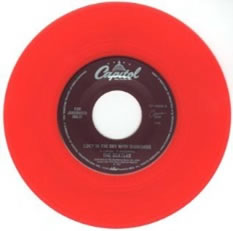 is a song credited to Lennon–McCartney that appears on the Beatles’ 1967 album Sgt. Pepper’s Lonely Hearts Club Band. It was started by John Lennon, then Paul McCartney contributed to it in a songwriting session.
is a song credited to Lennon–McCartney that appears on the Beatles’ 1967 album Sgt. Pepper’s Lonely Hearts Club Band. It was started by John Lennon, then Paul McCartney contributed to it in a songwriting session.
Lennon’s son Julian inspired the song with a nursery school drawing he called “Lucy—in the sky with diamonds”. Shortly after the song’s release, speculation arose that the first letter of each of the title nouns intentionally spelled “LSD”. Lennon consistently denied this, insisting the song’s fantastical imagery was inspired by Lewis Carroll’s Alice in Wonderland books,a claim repeatedly confirmed by Paul McCartney.
Composition
Most of the song is in simple triple metre (34 time), but the chorus is in 4 4 time. The song modulates between musical keys, using the key of A major for verses, B♭ major for the pre-chorus, and G major for the chorus. It is sung by Lennon over an increasingly complicated underlying arrangement which features a tamboura, played by George Harrison, lead electric guitar put through a Leslie speaker, played by Harrison, and a counter melody on Lowrey organ played by McCartney and taped with a special organ stop sounding “not unlike a celeste”. Session tapes from the initial 1 March 1967 recording of this song reveal Lennon originally sang the line “Cellophane flowers of yellow and green” as a broken phrase, but McCartney suggested that he sing it more fluidly to improve the song.
Origin
Julian’s drawing
Lennon’s inspiration for the song came when his son, Julian, showed him a nursery school drawing he called “Lucy—in the Sky with Diamonds”, depicting his classmate Lucy O’Donnell (later Lucy Vodden). Julian Lennon said, “I don’t know why I called it that or why it stood out from all my other drawings, but I obviously had an affection for Lucy at that age. I used to show Dad everything I’d built or painted at school, and this one sparked off the idea …” Vodden, in a BBC radio interview in 2007, said, “I remember Julian and I both doing pictures on a double-sided easel, throwing paint at each other, much to the horror of the classroom attendant … Julian had painted a picture and on that particular day his father turned up with the chauffeur to pick him up from school.” O’Donnell died in 2009 at age 46 after suffering from lupus.
According to both Lennon and Ringo Starr, who witnessed the moment, Julian first uttered the song’s title upon returning home from nursery school. Lennon later recalled of the painting and the phrase, “I thought that [it was] beautiful. I immediately wrote a song about it.”
LSD rumors
Rumors of the connection between the title of “Lucy in the Sky with Diamonds” and the initialism “LSD” began circulating shortly after the release of the Sgt. Pepper’s Lonely Hearts Club Band LP in June 1967. Paul McCartney gave two interviews that same month admitting to having taken the drug. Lennon later said he was surprised at the idea that the song title was a hidden reference to LSD, countering that the song “wasn’t about that at all”, and that it “was purely unconscious that it came out to be LSD. Until someone pointed it out, I never even thought of it. I mean, who would ever bother to look at initials of a title? … It’s not an acid song.”
Paul McCartney confirmed Lennon’s claim on several occasions, the earliest in 1968:
When you write a song and you mean it one way, and someone comes up and says something about it that you didn’t think of—you can’t deny it. Like “Lucy in the Sky with Diamonds,” people came up and said, cunningly, “Right, I get it. L-S-D,” and it was when [news]papers were talking about LSD, but we never thought about it.
McCartney further rebuffed the claims in a 1997 BBC Radio interview with Michael Parkinson by saying, “It wasn’t about LSD. Because otherwise it would have been called ‘LITSWD.’ Because the initials aren’t ‘LSD.’ Lucy in the sky with diamonds is more like that.”
In a 2004 interview with Uncut magazine, McCartney confirmed that it was “pretty obvious” drugs did influence some of the group’s compositions at that time, including “Lucy in the Sky with Diamonds”, though he tempered this analysis by adding, “[I]t’s easy to overestimate the influence of drugs on the Beatles’ music.”
In 2017, the first take of the song was issued leading up to the release of the 50th anniversary special edition of Sgt. Pepper’s Lonely Hearts Club Band; The story about Julian’s painting was confirmed as the inspiration of the song, as opposed to the LSD reference.
Alice In Wonderland
According to both Lennon and McCartney, the lyrics were largely derived from the literary style of Alice In Wonderland. Lennon had read and admired the works of Lewis Carroll, and the title of Julian’s drawing reminded him of the “Which Dreamed it?” chapter of Through the Looking Glass in which Alice floats in a “boat beneath a sunny sky”:
It was Alice in the boat. She is buying an egg and it turns into Humpty-Dumpty. The woman serving in the shop turns into a sheep and the next minute they are rowing in a rowing boat somewhere and I was visualizing that.
McCartney remembered of the song’s composition, “We did the whole thing like an Alice In Wonderland idea, being in a boat on the river … Every so often it broke off and you saw Lucy in the sky with diamonds all over the sky. This Lucy was God, the Big Figure, the White Rabbit.” He later recalled helping Lennon finish the song at Lennon’s Kenwood home, specifically claiming he contributed the “newspaper taxis” and “cellophane flowers” lyrics; Lennon’s 1968 interview with Rolling Stone magazine confirmed McCartney’s contribution.
Please Please Me
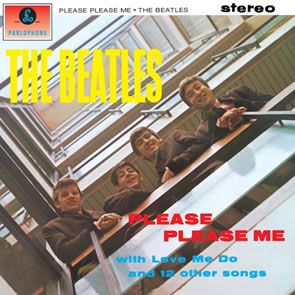 Is a song and the second single released by English rock group the Beatles in the United Kingdom, and the first to be issued in the United States. It was also the title track of their first LP, which was recorded to capitalize on the success of the single. It was originally a John Lennon composition (credited to Lennon–McCartney), although its ultimate form was significantly influenced by George Martin.
Is a song and the second single released by English rock group the Beatles in the United Kingdom, and the first to be issued in the United States. It was also the title track of their first LP, which was recorded to capitalize on the success of the single. It was originally a John Lennon composition (credited to Lennon–McCartney), although its ultimate form was significantly influenced by George Martin.
John Lennon: “Please Please Me is my song completely. It was my attempt at writing a Roy Orbison song, would you believe it? I wrote it in the bedroom in my house at Menlove Avenue, which was my auntie’s place”. (David Sheff. John Lennon: All We Are Saying).
The single was released in the UK on 11 January 1963 and reached No. 1 on the New Musical Express and Melody Maker charts. However, it only reached No. 2 on the Record Retailer chart, which subsequently evolved into the UK Singles Chart. Because of this it was not included on the multi-million selling Beatles compilation.
The single, as initially released with “Ask Me Why” on the B-side, failed to make much impact in the US in February 1963, but when re-released there on 3 January 1964 (this time with “From Me to You” on the B-side), it reached number three on the Billboard Hot 100.
Composition
The Beatles had accomplished a modest debut success with “Love Me Do”, but outside of Liverpool and Hamburg they were still practically unknown. Part of the problem was that the group was committed to begin what was to be their final Hamburg season just as “Love Me Do” entered the British charts and so was unable to actively promote it on their home soil. Nonetheless, their producer, George Martin, felt it was a promising start and decided to go ahead with a second single.
“Please Please Me” has a diverse history. George Martin has stated that the original version of this song was “rather dreary”, was too slow and consequently had little prospect of being the big hit the band were looking for. Martin said, “I was still thinking that we should release their [earlier] recording of “How Do You Do It?””, a previously taped Mitch Murray composition that Martin insisted the Beatles record which he had seriously considered as an alternative debut single instead of “Love Me Do”. The group replied that they were only interested in recording their own material. McCartney said: “It was symptomatic of our group that we turned down “How Do You Do It?”. Ringo Starr commented: “I remember us all being ready to stand up for the principle of, ‘We have written these songs and we want to do them'”. George Martin was ultimately sympathetic to their appeals, but said later: “[I] would still have issued “How Do You Do It?” had they not persuaded me to listen to another version of “Please Please Me”.
Lennon first conceived “Please Please Me” as a bluesy, slow tempo song. Lennon recalled: “I remember the day I wrote it, I heard Roy Orbison doing “Only the Lonely”, or something. And I was also always intrigued by the words to a Bing Crosby song that went, ‘Please lend a little ear to my pleas’. The double use of the word ‘please’. So it was a combination of Roy Orbison and Bing Crosby”. Originally it was vocally sparse, did not contain any harmonies or responses, nor did it have the scaled harmonica intro.
Recording
George Martin claimed he first heard it at the “Love Me Do” re-make session on 11 September. Ringo Starr in Anthology stated: “On my first visit in September we just ran through some tracks for George Martin. We even did Please Please Me. I remember that, because while we were recording it I was playing the bass drum with a maraca in one hand and a tambourine in the other.” John Lennon in Anthology stated: “We’d had a top 30 entry with Love Me Do and we really thought we were on top of the world. Then came Please Please Me — and wham! We tried to make it as simple as possible. Some of the stuff we’ve written in the past has been a bit way-out, but we aimed this one straight at the hit parade. … We almost abandoned it as the B-side of Love Me Do. We changed our minds only because we were so tired the night we did Love Me Do. We’d been going over it a few times and when we came to the question of the flipside, we intended using Please Please Me. Our recording manager, George Martin, thought our arrangement was fussy, so we tried to make it simpler. We were getting very tired, though, and we just couldn’t seem to get it right. We are conscientious about our work and we don’t like to rush things.”
In the opinion of George Martin, “At that stage Please Please Me was a very dreary song. It was like a Roy Orbison number, very slow, bluesy vocals. It was obvious to me that it badly needed pepping up. I told them to bring it in next time and we’d have another go at it.” He asked the Beatles to consider making major changes to it, including increasing its tempo. By the time it was brought back into the studio on 26 November 1962, its arrangement had been radically altered, and it took 18 takes to record what George Martin immediately predicted would be their first major hit. Paul McCartney in Anthology stated: “We sang it and George Martin said, ‘Can we change the tempo?’ We said, ‘What’s that?’ He said, ‘Make it a bit faster. Let me try it.’ And he did. We thought, ‘Oh, that’s all right, yes.’ Actually, we were a bit embarrassed that he had found a better tempo than we had.”
If the session notes and date attribution in the 1995 compilation “The Beatles Anthology 1” are correct, a faster-tempo version sans harmonica was recorded at Abbey Road on 11 September, the only session in which sessions drummer Andy White was present. The up-tempo track, No. 24 on “Anthology 1”, was believed to have been wiped until its rediscovery in 1994 during the “Anthology” production, with Anthology notes seeming to indicate that it features session drummer Andy White instead of Ringo Starr. The point is not addressed in the Mark Lewisohn-researched “Anthology” notes, although author Lewisohn’s 1988 “The Beatles Recording Sessions” quotes session engineer Ron Richards as saying, “Ringo didn’t play drums at all that evening.” However, recording technician Geoff Emerick later wrote that, following White’s departure, he witnessed Beatles roadie Mal Evans set up Starr’s kit and the group record “Please Please Me” with Starr on drums. The unexpected rediscovery of the 11 September up-tempo recording raises the questions of when the Orbison-inspired slow version was played for Martin and whether a tape of that version might also still exist in the Abbey Road vaults, inasmuch as Lewisohn’s 1988 quote from Martin “We didn’t keep outtakes then [1962]” was later contradicted. In a 2012 BBC interview, Andy White claimed that the drumming on the hit single was his:
“From the drum sound I can tell that I was on it, because it was a vastly different sound to Ringo’s drumset at that time. This was before he got the Ludwig kit. Each drummer gets an individual sound, first of all by the way they tune the drums and then by the way they play the drums.”
-Andy White
White, however was not at the studio for the final recording on 26 November and was only hired for the 11 September session. As recorded on 26 November, Lennon’s harmonica playing features prominently and, similar to other early Beatles’ compositions such as “Love Me Do” and “From Me to You”, opens the song. McCartney and Lennon initially share the vocals with McCartney holding a high note while Lennon drops down through the scale, a ploy they learned from the Everly Brothers UK hit song “Cathy’s Clown” (April 1960).
McCartney said: “I did the trick of remaining on the high note while the melody cascaded down from it”. Ringo Starr asserts himself, exorcising any lingering doubts from the “Love Me Do” sessions regarding his ability. Where “Love Me Do” had been arguably parochial, relying to a large extent on their existing home fans for support “Please Please Me” would be groundbreaking, especially as The Beatles were now back in the UK and able to appear on influential national television shows such as Thank Your Lucky Stars.
- If one were to accept Record Retailer’s chart positions for “Please, Please Me” and “How Do You Do It?”, then George Martin’s instincts for a number one hit were absolutely correct, the former reaching number two and the latter number one for Gerry & The Pacemakers.
- There are three different mixes of the song, two in mono and one in stereo. The mono mix that appears on the single is not the same as the Please Please Me album mix, as extra echo was added to the LP version. A new mix was created for the stereo version of the album, and on 25 February 1963 Martin made one created from original takes 16, 17 and 18. This stereo version has Lennon fluffing the final verse, causing him to sing ‘come on’ with a slight chuckle in his voice. Also different in the stereo mix is Harrison’s lead guitar line before the final verse; rather than duplicating the overdubbed harmonica exactly as he had earlier in the song, Harrison drops down a fourth for the third note, rather than continuing down by stepwise motion.
- It was credited to “McCartney–Lennon”, as were all other Lennon–McCartney originals on the Please Please Me album. The songwriting credit was changed to the more familiar “Lennon–McCartney” sequence for their second album, With the Beatles
All You Need is Love
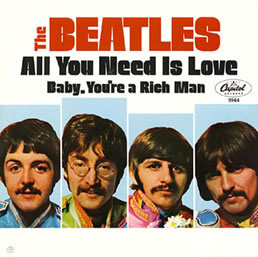 Is a song by the English rock band the Beatles that was released as a non-album single in July 1967. It was written by John Lennon and credited to Lennon–McCartney.
Is a song by the English rock band the Beatles that was released as a non-album single in July 1967. It was written by John Lennon and credited to Lennon–McCartney.
The Beatles performed the song over a pre-recorded backing track as Britain’s contribution to Our World, the first live global television link. Watched by over 400 million in 25 countries, the programme was broadcast via satellite on 25 June 1967.
The song captured the utopian sentiments of the Summer of Love era and topped singles charts in Britain, the United States and many other countries.
“All You Need Is Love” was later included on the US Magical Mystery Tour album. It also appears in a sequence in the Beatles’ 1968 animated film Yellow Submarine and on the accompanying soundtrack album.
Eleanor Rigby
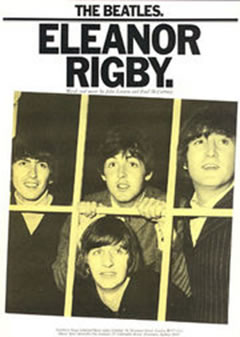 Is a song by the Beatles, released on the 1966 album Revolver and as a 45 rpm single. It was written primarily by Paul McCartney, and credited to Lennon–McCartney.
Is a song by the Beatles, released on the 1966 album Revolver and as a 45 rpm single. It was written primarily by Paul McCartney, and credited to Lennon–McCartney.
The song continued the transformation of the Beatles from a mainly rock and roll- and pop-oriented act to a more experimental, studio-based band.
With a double string quartet arrangement by George Martin and striking lyrics about loneliness, “Eleanor Rigby” broke sharply with popular music conventions, both musically and lyrically.
Richie Unterberger of AllMusic cites the band’s “singing about the neglected concerns and fates of the elderly” on the song as “just one example of why the Beatles’ appeal reached so far beyond the traditional rock audience.
Can’t Buy Me Love
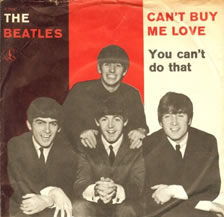
Is a song composed by Paul McCartney (credited to Lennon–McCartney) and released by the Beatles on the A-side of their sixth British single, “Can’t Buy Me Love/You Can’t Do That”. In September 2015, the Beatles donated the use of their recording of the song to People for the Ethical Treatment of Animals for a television commercial.
Composition
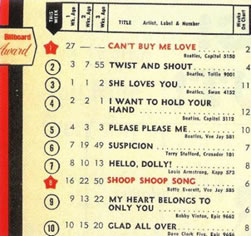 While in Paris, the Beatles stayed at the five star George V hotel and had an upright piano moved into one of their suites so that song writing could continue. It was here that McCartney wrote “Can’t Buy Me Love.” The song was written under the pressure of the success achieved by “I Want to Hold Your Hand” which had just reached number one in America. When producer George Martin first heard “Can’t Buy Me Love” he felt the song needed changing: “I thought that we really needed a tag for the song’s ending, and a tag for the beginning; a kind of intro. So I took the first two lines of the chorus and changed the ending, and said ‘Let’s just have these lines, and by altering the second phrase we can get back into the verse pretty quickly.'” And they said, “That’s not a bad idea, we’ll do it that way”.
While in Paris, the Beatles stayed at the five star George V hotel and had an upright piano moved into one of their suites so that song writing could continue. It was here that McCartney wrote “Can’t Buy Me Love.” The song was written under the pressure of the success achieved by “I Want to Hold Your Hand” which had just reached number one in America. When producer George Martin first heard “Can’t Buy Me Love” he felt the song needed changing: “I thought that we really needed a tag for the song’s ending, and a tag for the beginning; a kind of intro. So I took the first two lines of the chorus and changed the ending, and said ‘Let’s just have these lines, and by altering the second phrase we can get back into the verse pretty quickly.'” And they said, “That’s not a bad idea, we’ll do it that way”.
The song’s verse is a twelve bar blues in structure, a formula that the Beatles seldom applied to their own material
US music charts
- The Beatles established four records on the Billboard Hot 100 with “Can’t Buy Me Love” at number one:
Until Billboard began using SoundScan for their charts in 1991, it had the biggest jump to number one: (number twenty-seven to number one; no other single had ever done this). - It gave the Beatles three consecutive number-one songs (“I Want to Hold Your Hand” was replaced at number one by “She Loves You” which was in turn replaced by “Can’t Buy Me Love”). The three songs spent a combined total of 14 consecutive weeks at No.1. This is the only time an artist had three number ones in a row. The best prior was Elvis, who had two consecutive number ones with “Don’t Be Cruel” and “Love Me Tender”.
- When “Can’t Buy Me Love” reached number one (4 April 1964), the entire top five of the Hot 100 was by the Beatles, the next positions being filled by “Twist and Shout”, “She Loves You”, “I Want to Hold Your Hand” and “Please Please Me,” respectively. No other act has held the top five spots simultaneously.
- During its second week at number one (11 April 1964), the Beatles had fourteen songs on the Hot 100 at the same time.
Penny Lane
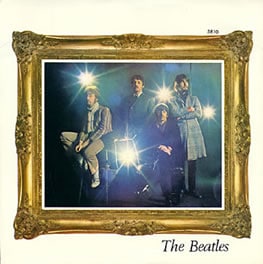 Is a song by the Beatles. It was written primarily by Paul McCartney but credited to the Lennon–McCartney songwriting partnership. The lyrics refer to a real street in Liverpool, England.
Is a song by the Beatles. It was written primarily by Paul McCartney but credited to the Lennon–McCartney songwriting partnership. The lyrics refer to a real street in Liverpool, England.
Recorded during the Sgt. Pepper album sessions, and intended for inclusion, “Penny Lane” was released in February 1967 as one side of a double A-sided single, along with “Strawberry Fields Forever”, following pressure from EMI, the Beatles record company, after several months absence of new material. Although the song did not top the charts in Britain, it was still a top ten hit across Europe. The song would make its LP debut on the US version of the band’s album, Magical Mystery Tour, rather than on the British double EP on which the LP was based.
Recording
Production began in Studio 2 at Abbey Road on 29 December 1966 with piano as the main instrument. On 17 January 1967, trumpet player David Mason recorded the piccolo trumpet solo. The solo, which was the result of a suggestion from Paul after seeing a BBC performance of Johann Sebastian Bach’s second Brandenburg Concerto, is in a mock-Baroque style for which the piccolo trumpet (a small instrument built about one octave higher than the standard instrument) is particularly suited, having a clean and clear sound which penetrates well through thicker midrange textures.
According to lead sound engineer Geoff Emerick, David Mason “nailed it” at some point during the recording; Paul McCartney tried to get him to do another take but producer George Martin insisted it wasn’t necessary, sensing Mason’s fatigue. Emerick also notes in his book that prior to this recording, the high “E” was considered unobtainable by trumpet players and has been expected of them since said performance on the record. Mason was paid 27 pounds and 10 shillings for his performance on the recording. “Penny Lane’s production effects include percussion effects and piano through a Vox guitar amplifier with added reverb.
The original US promo single mix of “Penny Lane” had an additional flourish of piccolo trumpet notes at the end of the song. This mix was quickly superseded by one without the last trumpet passage, but not before a handful of copies had been pressed and sent to radio stations. These recordings are among the rarest and most valuable Beatles collectibles. A stereo mix of the song with the additional trumpet added back in was included on the US Rarities compilation and the UK album The Beatles Box in 1980, and is included on an alternate take of the song released on Anthology 2 in 1996.
Composition
The song has a double tonic structure of B major verse (in I–vi–ii–V cycles) and A major chorus connected by formal pivoting dominant chords. In the opening bars in B major, after singing “In Penny Lane” (in an F♯–B–C♯–D♯ melody note ascent) McCartney sings the major third of the first chord in the progression (on “Lane”) and major seventh (on “barber”) then switches to a Bm chord, singing the flattened third notes (on “know” with a i7 [Bm7] chord) and flattened seventh notes (on “come and go” [with a ♭VImaj7 [Gmaj7] chord] and “say hello” [with a V7sus4 [F♯7sus4] chord]).[18] This has been described as a profound and surprising innovation involving abandoning mid-cycle what initially appears to be a standard I–vi–ii–V doo-wop pop chord cycle. To get from the verse “In the pouring rain – very strange” McCartney uses an E chord as a pivot, (it is a IV chord in the preceding B key and a V in the looming A key) to take listeners back into the chorus (“Penny Lane is in my ears …”). Likewise to get back from the chorus of “There beneath the blue suburban skies I sit, and meanwhile back … , McCartney uses an F♯7 pivot chord (which is a VI in the old A key and a V in the new B key). The lyrics “very strange” and “meanwhile back” can be viewed as hinting at these complex tonal changes.
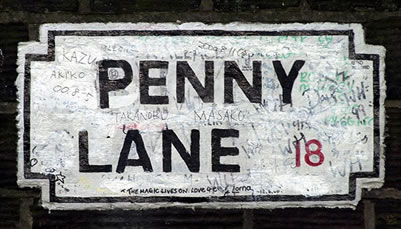
A feature of the song was the piccolo trumpet solo played by Mason. This is thought to be the first use of this instrument (a distinctive, specialty instrument, pitched an octave higher than the standard B-flat trumpet) in pop music. Martin later wrote, “The result was unique, something which had never been done in rock music before.” McCartney was dissatisfied with the initial attempts at the song’s instrumental fill (one of which, recorded 12 January and featuring two cors anglais played by Dick Morgan and Mike Winfield, was released on Anthology 2), and was inspired to use the instrument after seeing Mason’s performance on a BBC television broadcast of the second Brandenburg Concerto by Johann Sebastian Bach.
The song features contrasting verse–chorus form. Lyrically there are several ambiguous and surreal images. The song is seemingly narrated on a fine summer day (“beneath the blue suburban skies”), yet at the same time it is raining (“the fireman rushes in from the pouring rain”) and approaching winter (“selling poppies from a tray” implies Remembrance Day, 11 November). Ian MacDonald has stated: “Seemingly naturalistic, the lyric scene is actually kaleidoscopic. As well as raining and shining at the same time, it is simultaneously summer and winter.”
We Can Work It Out
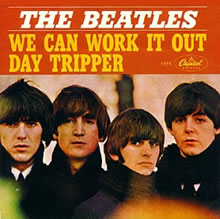 Is a song by the English rock band the Beatles, written by Paul McCartney and John Lennon. It was first issued as a double A-side single with “Day Tripper” in December 1965. The release marked the first time in Britain that both tracks on an artist’s single wre promoted as joint A-sides. The song was recorded during the sessions for the band’s Rubber Soul album.
Is a song by the English rock band the Beatles, written by Paul McCartney and John Lennon. It was first issued as a double A-side single with “Day Tripper” in December 1965. The release marked the first time in Britain that both tracks on an artist’s single wre promoted as joint A-sides. The song was recorded during the sessions for the band’s Rubber Soul album.
“We Can Work It Out” is a comparatively rare example of a Lennon–McCartney collaboration from this period in the Beatles’ career, in that it recalls the level of collaboration the two songwriters had shared when writing the group’s hit singles of 1963. This song, “A Day in the Life”, “Baby, You’re a Rich Man” and “I’ve Got a Feeling”, are among the notable exceptions.
Hello Goodbye
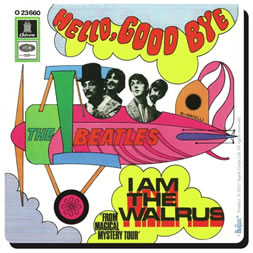 Is a song by the English rock band the Beatles, written by Paul McCartney and credited to Lennon–McCartney. Backed by John Lennon’s “I Am the Walrus”, it was issued as a non-album single in November 1967, the group’s first release since the death of their manager, Brian Epstein. The single was commercially successful around the world, topping charts in the United States, the United Kingdom, Canada, Australia and several other countries.
Is a song by the English rock band the Beatles, written by Paul McCartney and credited to Lennon–McCartney. Backed by John Lennon’s “I Am the Walrus”, it was issued as a non-album single in November 1967, the group’s first release since the death of their manager, Brian Epstein. The single was commercially successful around the world, topping charts in the United States, the United Kingdom, Canada, Australia and several other countries.
McCartney later said that the lyrics take duality as their theme. The song originated when, in response to a question from Beatles aide Alistair Taylor about songwriting, McCartney sat down at a harmonium and asked Taylor to say the opposite of whatever he said. The completed song includes a musical coda, which was improvised by the Beatles when they were recording the track in October 1967. Unimpressed with the composition, Lennon pushed for “I Am the Walrus” to be the single’s A-side, but McCartney and the band’s producer, George Martin, opted for the more commercial-sounding “Hello, Goodbye”. The Beatles produced three promotional films for the song, one of which was shown on The Ed Sullivan Show in America. Due to regulations against lip-syncing in Britain, none of the clips were aired there.
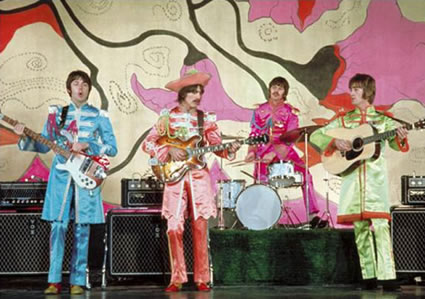
“Hello, Goodbye” has traditionally received a varied response from music critics. While some reviewers praise the song for its classic pop qualities, others deem it unadventurous by the Beatles’ standards and inconsequential. The track was included on the expanded US release of the Magical Mystery Tour soundtrack EP, and later appeared on compilation albums such as 1967–1970 and 1. McCartney has often performed “Hello, Goodbye” in concert, beginning with his Driving World Tour in 2002. James Last, Bud Shank, Allen Toussaint, the Cure and the cast of Glee are among the acts who have also recorded the song.
Get Back
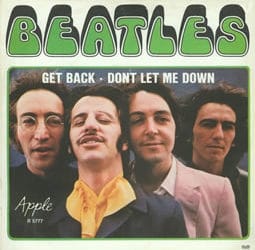 is a song recorded by the Beatles and written by Paul McCartney (though credited to Lennon-McCartney), originally released as a single on 11 April 1969 and credited to “The Beatles with Billy Preston.” A different mix of the song later became the closing track of Let It Be (1970), which was the Beatles’ last album released just after the group split. The single version was later issued on the compilation albums 1967–1970, 20 Greatest Hits, Past Masters, and 1.
is a song recorded by the Beatles and written by Paul McCartney (though credited to Lennon-McCartney), originally released as a single on 11 April 1969 and credited to “The Beatles with Billy Preston.” A different mix of the song later became the closing track of Let It Be (1970), which was the Beatles’ last album released just after the group split. The single version was later issued on the compilation albums 1967–1970, 20 Greatest Hits, Past Masters, and 1.
The single reached number one in the United Kingdom, the United States, Ireland, Canada, New Zealand, the Netherlands, Australia, France, West Germany, Mexico, Norway, Switzerland, Austria, and Belgium. It was the Beatles’ only single that credited another artist at their request. “Get Back” was the Beatles’ first single release in true stereo in the US. In the UK, the Beatles’ singles remained monaural until the following release, “The Ballad of John and Yoko”.
Drive My Car
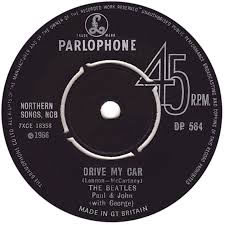 Is a song by the Beatles, written primarily by Paul McCartney, with lyrical contributions from John Lennon. It was first released on the British version of the band’s 1965 album Rubber Soul; it also appeared in North America on the Yesterday and Today collection. The upbeat, lighthearted “Drive My Car” was used as the opening track for both albums. Over the years the song has been covered by many artists such as former Spice Girls member Melanie C and Lulu, and the US band Breakfast Club. which was featured in the 1988 film License to Drive, that was played over the opening credits.
Is a song by the Beatles, written primarily by Paul McCartney, with lyrical contributions from John Lennon. It was first released on the British version of the band’s 1965 album Rubber Soul; it also appeared in North America on the Yesterday and Today collection. The upbeat, lighthearted “Drive My Car” was used as the opening track for both albums. Over the years the song has been covered by many artists such as former Spice Girls member Melanie C and Lulu, and the US band Breakfast Club. which was featured in the 1988 film License to Drive, that was played over the opening credits.
Lyrics
The song’s male narrator is told by a woman that she is going to be a famous movie star, and she offers him the opportunity to be her chauffeur, adding: “and maybe I’ll love you”. When he objects that his “prospects [are] good”, she retorts, “Working for peanuts is all very fine/But I can show you a better time.” When he agrees to her proposal, she admits, “I got no car and it’s breakin’ my heart/But I’ve found a driver and that’s a start.” According to McCartney, “‘Drive my car’ was an old blues euphemism for sex”. This expression was more common in the pre-automatic shift era of automobiles.
Composition
When McCartney arrived at Lennon’s Weybridge home for a writing session, he had the tune in his head, but “The lyrics were disastrous, and I knew it.” The chorus began, “You can buy me diamond rings”, a cliché they had used twice before, in “Can’t Buy Me Love” and “I Feel Fine” (as well as in the discarded “If You’ve Got Trouble”). Lennon dismissed the lyrics as “crap” and “too soft”. They decided to rewrite the lyrics and after some difficulty – McCartney said it was “one of the stickiest” writing sessions – they settled on the “drive my car” theme (which Bob Spitz credits to Lennon) and the rest of the lyrics flowed easily from that.
It has been suggested that the song also refers to the relationship between Cilla Black and her then boyfriend Bobby Willis (whom she later married). Black was both a friend of the Beatles and a protegée of Brian Epstein. As the TV mini-series “Cilla” revealed, Willis was also offered a recording contract by Epstein, but Black objected, saying that she was the “star” and Willis was to be the road manager who would “drive my car”.
Recording
“Drive My Car” was recorded on 13 October 1965 during the Beatles’ first recording session to extend past midnight. McCartney worked closely with George Harrison on the basic rhythm track, the pair playing, in author Ian MacDonald’s description, “similar riffing lines on bass and low guitar”, respectively, as per Harrison’s suggestion. Harrison had been listening to Otis Redding’s “Respect” at the time and, as a result of this influence, “Drive My Car” contains more bottom end than previous Beatles recordings, mimicking the bass-heavy sound captured in Redding’s Memphis studio. Author Robert Rodriguez describes the track as an “overt R&B workout” and a rare example of the Beatles demonstrating their admiration of Stax and Motown artists on the mostly folk rock-oriented Rubber Soul.
McCartney sang the main vocal part, giving it an energetic push that journalist Richie Unterberger calls “a commanding … hard rock vocal”. The vocal rides above a simple two-chord funk riff in the verse, and a much more complex chorus containing piano-driven jazz-style key modulations. McCartney overdubbed both the piano part and the slide guitar solo.
Eight Days a Week
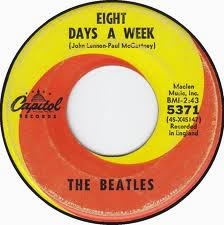 is a song by the English rock band the Beatles. It was written by Paul McCartney and John Lennon based on McCartney’s original idea.
is a song by the English rock band the Beatles. It was written by Paul McCartney and John Lennon based on McCartney’s original idea.
The song was released in the United Kingdom in December 1964 on the album Beatles for Sale. In the United States, it was first issued as a single in February 1965 before appearing on the North American release Beatles VI. The song was the band’s seventh number 1 single on the Billboard Hot 100, a run of US chart success achieved in just over a year. The single was also number 1 in Canada, Belgium and the Netherlands.
The Beatles recorded “Eight Days a Week” at EMI Studios in London in October 1964.
The track opens with a fade-in, marking the first time that this technique had been used on a pop studio recording. The song was reissued worldwide in 2000 on the Beatles compilation album 1. It also provided the title for director Ron Howard’s 2016 documentary film on the band’s years as live performers, The Beatles: Eight Days a Week.
All My Loving
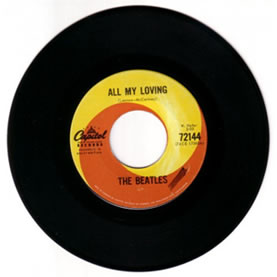 A song by the English rock band the Beatles, written by Paul McCartney (credited to Lennon–McCartney), from the 1963 album With the Beatles. Though it was not released as a single in the United Kingdom or the United States, it drew considerable radio airplay, prompting EMI to issue it as the title track of an EP.
A song by the English rock band the Beatles, written by Paul McCartney (credited to Lennon–McCartney), from the 1963 album With the Beatles. Though it was not released as a single in the United Kingdom or the United States, it drew considerable radio airplay, prompting EMI to issue it as the title track of an EP.
The song was released as a single in Canada, where it became a number one hit. The Canadian single was imported into the US in enough quantities to peak at number 45 on the Billboard Hot 100 in April 1964.
Nowhere Man
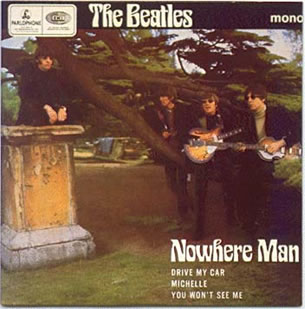
Recorded on 21 and 22 October 1965, “Nowhere Man” is one of the first Beatles songs to be entirely unrelated to romance or love, and marks a notable instance of Lennon’s philosophically oriented songwriting. It was released as a single (although not in the United Kingdom) on 21 February 1966, and reached number 1 in Australia and Canada and number 3 on the Billboard Hot 100. Similarly to what had happened a year earlier (“Eight Days a Week” and “I Don’t Want to Spoil the Party” were on Beatles for Sale but not on Beatles ’65), “Nowhere Man” and “What Goes On” were not on the US version of Rubber Soul (released in December around the same time as the British version), but were back-to-back on a subsequent single and later (in June) on an album (Yesterday and Today).
Lennon, Paul McCartney, and George Harrison sing the song in three-part harmony. The song appears in the film Yellow Submarine, where the Beatles sing it about the character Jeremy Hillary Boob after meeting him in the “nowhere land”.
The lead guitar lines on the song were performed in unison by Harrison and Lennon.The pair played identical “sonic blue”-coloured Fender Stratocasters.
Sgt Pepper/With a Little Help From My Friends
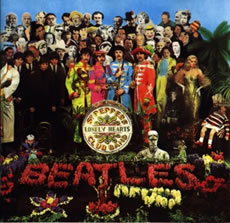 Sgt. Pepper’s Lonely Hearts Club Band” is a song written by Paul McCartney (credited to Lennon–McCartney), and first recorded and released in 1967, on the album of the same name by the Beatles. The song appears twice on the album: as the opening track (segueing into “With a Little Help from My Friends”), and as “Sgt. Pepper’s Lonely Hearts Club Band (Reprise)”, the penultimate track (segueing into “A Day in the Life”). As the title song, the lyrics introduce the fictional band that performs on the album.
Sgt. Pepper’s Lonely Hearts Club Band” is a song written by Paul McCartney (credited to Lennon–McCartney), and first recorded and released in 1967, on the album of the same name by the Beatles. The song appears twice on the album: as the opening track (segueing into “With a Little Help from My Friends”), and as “Sgt. Pepper’s Lonely Hearts Club Band (Reprise)”, the penultimate track (segueing into “A Day in the Life”). As the title song, the lyrics introduce the fictional band that performs on the album.
Authorship and recording
In November 1966, on the flight back to England after a holiday, McCartney conceived an idea in which an entire album would be role-played, with each of the Beatles assuming an alter-ego in the “Lonely Hearts Club Band”, which would then perform a concert in front of an audience. The inspiration is said to have come when roadie Mal Evans innocently asked McCartney what the letters “S” and “P” stood for on the pots on their in-flight meal trays, and McCartney explained it was for salt and pepper. This then led to the Sgt. Pepper’s Lonely Hearts Club Band concept, as well as the song.
The group’s road manager, Neil Aspinall, suggested the idea of Sgt. Pepper being the compère, as well as the reprise at the end of the album. According to his diaries, Evans may have also contributed to the song. John Lennon attributed the idea for Sgt. Pepper to McCartney, although the song is officially credited to Lennon–McCartney. The Beatles recorded the track in Abbey Road’s studio 2, with George Martin producing, and Geoff Emerick engineering. Work on the song started on 1 February 1967, and after three further sessions the recording was completed on 6 March 1967.
Song structure
On the Sgt. Pepper’s Lonely Hearts Club Band album, the song opens to the sound of a chattering audience, and an orchestra tuning up, which was taken from the 10 February orchestra session for “A Day in the Life”. The crowd sounds edited into the song were recorded in the early 1960s by Martin, during a live recording of the stage show Beyond the Fringe. The song’s structure is:
1. Introduction (instrumental)
2. Verse
3. Bridge (instrumental)
4. Refrain
5. Bridge
6. Verse
7. Instrumental bridge and transition into “With a Little Help from My Friends”.
The song is in G major, with a 44 meter. A horn quartet was used to fill out the instrumental sections”. With a Little Help from My Friends” is a song by the Beatles, written by Paul McCartney and John Lennon, from the album Sgt. Pepper’s Lonely Hearts Club Band issued worldwide in June 1967. The song was written for and sung by the Beatles’ drummer Ringo Starr as the character “Billy Shears”. The song, paired with “Sgt. Pepper’s Lonely Hearts Club Band” and featuring “A Day in the Life” as its B-side, was reissued as a single in the U.S. in August 1978 (#71) and in the U.K. in September 1978 (#63). “With a Little Help from My Friends” was ranked No. 311 on Rolling Stone’s list of the 500 Greatest Songs of All Time.
Origins
Lennon and McCartney finished writing this song in mid-March 1967, written specifically as Starr’s track for the album. McCartney said: “It was pretty much co-written, John and I doing a work song for Ringo, a little craft job.” In 1970 Lennon stated: “Paul had the line about ‘a little help from my friends.’ He had some kind of structure for it, and we wrote it pretty well fifty-fifty from his original idea.”, but in 1980 Lennon said: “This is Paul, with a little help from me. ‘What do you see when you turn out the light/ I can’t tell you, but I know it’s mine…’ is mine.” It was briefly called “Bad Finger Boogie” (later the inspiration for the band name Badfinger), supposedly because Lennon composed the melody on a piano using his middle finger after having hurt his forefinger.
Lennon and McCartney deliberately wrote a tune with a limited range – except for the last note, which McCartney worked closely with Starr to achieve. Speaking in the Anthology, Starr insisted on changing the first line which originally was “What would you think if I sang out of tune? Would you throw ripe tomatoes at me?”; he changed the lyric so that fans would not throw tomatoes at him should he perform it live. (In the early days, after George Harrison made a passing comment that he liked jelly babies, the group was showered with them at all of their live performances.)
The song’s composition is unusually well documented as Hunter Davies was present and described the writing process in the Beatles’ official biography.
The song is partly in the form of a conversation in which the other three Beatles sing a question — e.g. “Would you believe in a love at first sight?” where Starr answers, “Yes, I’m certain that it happens all the time.”
Recording
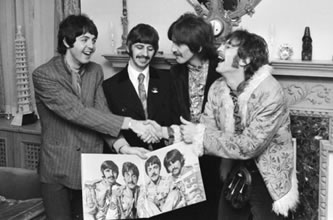
The Beatles began recording the song on 29 March 1967, the day before they posed for the Sgt. Pepper album cover. They recorded 10 takes of the song, wrapping up sessions at 5:45 in the morning. The backing track consisted of Starr on drums, McCartney playing piano, Harrison playing lead guitar and Lennon beating a cowbell. At dawn, Starr trudged up the stairs to head home – but the other Beatles cajoled him into doing his lead vocal then and there, standing around the microphone for moral support. The following day they added tambourine, backing vocals, bass and more electric guitar.
